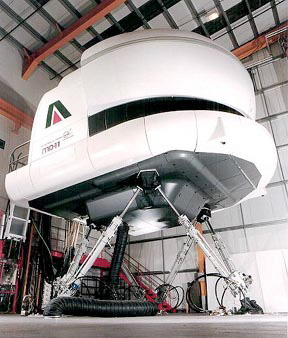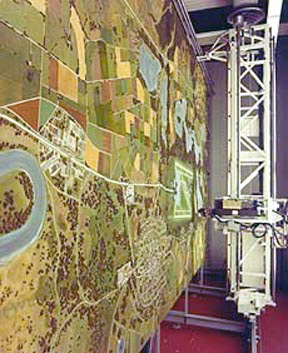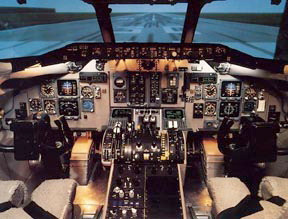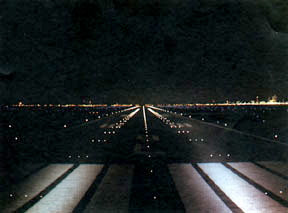Chapter 13: Flight Simulation
13.1 Phase I-III


Rolfe and Staples, in their 1986 book Flight Simulation, note that “the object of flight simulation is to reproduce on the ground the behavior of an aircraft in flight.” This includes the use of physical simulators, with the real and perceived motion that satisfy the motion cues expected by the human pilot, as well as the extremely important visual system, which includes the generation and display of a simulated perspective view of the outside world. These two are inextricably linked, as the visual response can trigger perceptions in the physical reaction, and vice versa. In 1986 there were over 500 simulators in use. We will review a few that have had an impact on the field of computer graphics and animation.

The early visual systems, dating from the late 1950s or early 1960s, included film systems and closed circuit television systems. The film system used a 35mm or 70 mm film that was shot from a real airplane. Servo driven optics distorted the image to simulate a range of other flight paths responding to pilot interaction. The CCTV system moved a camera with a special optical lens over a physical terrain model, or terrain board. Neither approach was very practical, even though high degrees of realism could be achieved, because variations were not easy to present, and situations that may confront a pilot in flight were limited. These early systems were replaced in the early 1970s with CGI systems, or CIG (Computer Image Generators) as they were often called.
The first computer image generation systems for simulation (Phase I) were produced by the General Electric Company (USA) for the space program. Early versions of these systems produced a patterned “ground plane” image, while later systems were able to generate images of three-dimensional objects.

Night-only systems usually used vector devices, rather than the raster scan display that gives the image complexity used today. The first of these systems was produced by the McDonnell-Douglas Electronics Corporation in 1971 and was called Vital II (Virtual Image Takeoff And Landing). It was certified by the FAA for commercial flight training for Pacific Southwest Airlines in 1972. The scene was only a night scene of an airport, showing the light pattern of the runways. As an FAA commercial Phase II system, it had to be capable of showing directional lights (only visible from certain directions), flashing lights or beacons, runway end illuminator lights, and vertical approach slope indicators, which are white when the correct approach slope is maintained, and red otherwise.


Phase III systems, on the other hand, were required to show day scenes of greater detail. The airport had to be recognizable, and terrain and physical landmarks had to be visible. In order to adequately represent these complex visual images, raster systems were employed.
Military simulation systems require significantly more complexity than the “takeoff/landing” visual simulations for commercial simulators. They require the simulation of complicated maneuvers, perhaps carrier landing, high speed flight, ground attack situations, etc. The vector devices used for many commercial systems were not sufficient, and the industry embarked on serious research and development efforts that both contributed to and took advantage of parallel efforts in CGI for special effects activities for movies, etc.
A Brief History of Aircraft Flight Simulation
Ray Page
J.M. Rolfe and K.J. Staples, Flight Simulation, Cambridge University Press, London, 1986
A Brief Introduction to the Art of Flight Simulation Ron Reisman
E1990b_159
“Computers in Spaceflight: The NASA Experience”
http://www.hq.nasa.gov/pao/History/computers/Ch9-2.html
Movie 13.1 Flight Simulation
